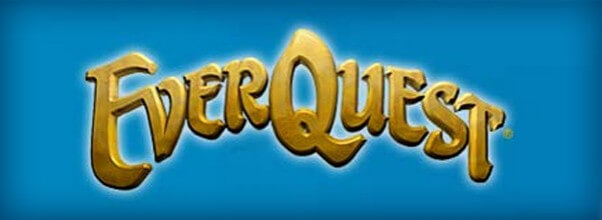Sometimes the best observations about life are made when one is away from the familiar — be it people, jobs, hobbies or past-times. A recent autumn drive through the scenic Cascade Mountains of Washington State gave me chance to reminisce about my love for online gaming. A beautiful vista of a lake or a forest would unlock a particular memory of when I was playing online during those first wonder years when I became involved in the genre.
I honestly look forward to extended periods of time spent away from my computer and the virtual worlds I visit. I find being out of my comfort zone stimulates my imagination. To get an accurate and honest picture of something sometimes you must get out of the shade of the trees and see the whole forest. It is in this spirit I always go back and ponder the phenomenon of the online game that started it all for me: EverQuest. Why was it so incredibly successful? What was the real magic behind it? What lessons can we learn for the future?
Since the release of EverQuest over 6 years ago, many MMO gamers have speculated about what made that game so amazingly addictive. Analyzing what made EQ so “magic” is a full-time occupation for many MMO discussion board participants. There have been many theories put forward that are partially right. Many claim that EQ was addictive because it was the first online game that superimposed a 3D graphics engine on top of a wildly popular text virtual world called a multi-user dungeon or MUD.
Others claim that it employed a class-based system of level advancement that encouraged group interdependency which created shared challenges and social-bonds that kept players coming back. Even more will pontificate that EQ which for many of us was our first online gaming experience is the standard by which we judge all subsequent online games by and none will every be able to compare to the original.
All of the previous explanations are partially right and help to explain with great validity why EverQuest was so successful. Still there is one principle that the creators of EverQuest employed that I believe is the true secret of the games success. It is so obvious that it was staring us all in the face for all those years.
I will begin my observation with a question:
What is the most powerful character level in EverQuest?
A) level 1 character
B) level 70 character
If you answered “A” a level 1 player you would be correct in my view. But how can this be? In relative terms the level 1 player can stand toe to toe with a level 1 mob and has a far greater chance of victory in combat then a level 70 player does versus a level 70 mob. At level 1 both the PC and the NPC have relatively similar hit points, AC and damage per second. At level 70 the NPC opponent has exponentially eclipsed the level 70 players hit points, AC and damage per second where it would most likely take a raid to be vanquished.
The EverQuest Paradox:
Player characters grow weaker in relation to non-player characters of an equivalent level as they increase in level.
At the early levels both players and mobs share almost the same attributes but then something interesting happens — the mobs start to get tougher faster then the player. I first noticed that just playing the game and later realized that the consider system changes from solo to group and then from group to raid. A level 1-10 player may consider an even “con” white mob to be a relatively even fight whereas a level 30 group would consider a single level 30 NPC foe an even con. Eventually a raid force of level 70 players will consider a level 70 NPC as an even opponent, considering that most level 70 NPC’s would be considered “boss” mobs.
Not only do NPC’s become more powerful then players they do so at an exponential rate. I recall years ago visiting a Geocities website called EverQuest Mobs to test this hypothesis. The website listed the hit points of every mob in every zone from data gathered from a EQ hack called ShowEQ. Thanks to the way back machine archive I was able to find the hit point values of atypical mobs and use them to create the following graph:

Here we can see that although mobs seem to have a consistent hit points advantage from levels 1-30, the gap starts to increase dramatically and exponentially at levels 40-60. The data on this graph was obtained from both the EverQuest Mobs and the EQRankings websites. The data only includes the original EQ and the first expansion Ruins of Kunark so I was not able to get a sample of level 70 mobs.
Understanding this paradox is critical in evaluating why EverQuest was so enjoyable and successful. Online worlds like EverQuest promise a player that their avatars will increase in power as they level. Naturally the idea of character advancement that is very appealing yet when we look at the data from EQ it is merely an illusion. All the player can really do is become more “skilled” in order to compensate for the fact that his power diminishes gradually over time. Therefore the player grows relatively weaker as he grows personally stronger, hence the paradox. This paradox essentially defined and drove the EverQuest phenomenon because it presented every player with a set of continuing challenges that were appropriate for his level. Raph Koster explains it best in his excellent book A Theory of Fun for Game Design with the following quote:
Real fun comes from the challenges that are always at the margin of our ability.
EverQuest comes very close to attaining this “holy grail” of game design philosophy. No matter what level you are in EverQuest, the garden variety mobs that you have to defeat to obtain experience points keep getting harder and require you as a player to improve your character. It is a well-established fact that in the realm of professional sports such as tennis, the only way a player can improve is by playing better opponents.
The same is true in EverQuest as character advancement is only possible if a player continually improves his character by becoming more skilled by combating progressively harder mobs. If the EverQuest devs had failed to employ the paradox then the game would have become dull and boring very early on and would not have been the resounding success that it was and still is today. EverQuest is fun because it provides the player with a sequence of reasonable challenges that one must overcome in order to progress to the next level.
By continually raising the bar of skill required to proceed, the designers of EverQuest initiated a chain reaction of progressively harder challenges that each player needed to master in order to succeed in their virtual world. These challenges had a trickle down effect and impacted core elements of the game and I have listed some of them here:
Item Acquisition and Collector Mentality
- – As players level they must become more proficient to defeat increasingly harder NPC’s and therefore must increase their individual skill as well as acquire more items, abilities and spells to build up their characters. This creates a paradigm where the player must actively seek out to improve his character by all means or face stagnation. As long as there are tougher monsters and better gear, the player always has a reason to keep playing to improve his character. Item acquisition and the collector mentality also help to support and fuel a thriving virtual world economy.
Group Interdependency
- – As players level they find they can no longer kill NPC’s by themselves and are required to develop good interpersonal skills and maintain a good reputation along with maintaining a good level of competency if they are to join a group of other players that will pool their skills and talents to defeat harder NPC’s. Group-interdependency helps players to form cohesive social bonds with other players and increases subscriber retention.
Guild Membership -As players level they find they can no longer obtain items either solo or from groups that are necessary to strengthen their character’s abilities and are required to develop good interpersonal skills and maintain a good reputation if they are to join a guild of other players that will pool their skills and talents to defeat harder NPC’s. Guild membership helps players to form cohesive social bonds with other players and increases subscriber retention.
Social Interaction and Good Conduct – As mentioned previously, the fact that a player must maintain a good reputation on his server helps to promote a sense of fair-play and good social order. Those players that develop a bad reputation will find that they will have a harder time finding admittance into groups and guilds which will severely impact their characters advancement. Contrast this with games like World of Warcraft where a player can solo to level 60 and not have to worry about finding groups, joining guilds and maintaining a good personal reputation.
Delivery 0f Appropriate Challenge – The increasingly difficult challenges found in the EverQuest Paradox serves as a gentle gatekeeper to keep out unskilled players from areas that are too difficult as the risk of losing experience by dying to tougher mobs is too great. As a player improves in power and skill they have increased mobility and can travel with relative safety to areas to hunt that are at the limit of their ability. Experience point rewards, consider mechanisms and a death penalty also ensure that players are experiencing content in areas that are appropriate for them.
Consistent Expectation of Player Performance – Players in EverQuest must continually improve or they simply can not advance. The rate of improvement expected of a player is fairly gradual and gives the player ample enough time to learn his class and acquire items along the way. If the slope of the learning cure is flat like World of Warcraft and suddenly requires a player to become proficient at level 60, then a player is ill-served and can be frustrated. If the slope of the learning curve is too steep at the outset, the player will quit out of frustration.
The true essence of EverQuest is one of character advancement that thrives off of continuously scaled challenge. This was made possible by utilizing the principles of the EverQuest Paradox which has largely been taken for granted until the release of online games like World of Warcraft. Many EverQuest veterans have found that WoW lacks the kind of challenge they were used to in the world of Norrath. Part of the reason could be that WoW is very derivative of EQ and since many players have mastered the basics of MMORPGs they apply their well-established skill sets to breeze through WoW and then complain about the lack of skill required by the game. I believe that the designers at Blizzard could have employed the EverQuest Paradox and reduced the exponentiality of the difficulty curve and it would have still been wildly successful. Whether WoW can retain subscribers with their current level of difficulty is another matter entirely.
Another benefit of the EverQuest Paradox and probably the most important thing for online games is the sense of community and social bonds that resulted from an unforgiving virtual world where progress is hard won and ever-increasing challenge is a constant — for me this is the true genius and legacy of EverQuest. Banding together to face a common enemy has long been part of the human experience from our days as hunter gathers to today’s modern civilization. As humans we usually don’t seek out adversity — it finds us. I wager most of us who played online games didn’t seek out community initially but now we’ve come to treasure and value it. There is nothing like that feeling of solidarity and community that people feel when they face a common enemy as recent world events such as disasters and conflicts have shown.
Conclusion
As a child I used to welcome the snowstorms that would blanket our tiny Canadian town. We’d all forget our differences and help our neighbors and passing strangers push their stuck cars out of the massive snow drifts. It was a rare sense of community and camaraderie that would descend upon our small street during those winter months.
Like the gift of snow, shared adversity is also a gift for virtual worlds in that we as players staring alone at our monitors can experience the bonds of community and fellowship despite being thousands of miles away from each other. EverQuest transcended fantasy gaming into a shared experience that gave thousands of players years of lasting enjoyment. Whether by design or accident, the formula was indeed magic and the designers of the virtual worlds of tomorrow would do well to learn and unlock its secrets.
–Wolfshead
(note: this article was also published at Gamergod.com)






Awesome article, and so bloody true.
Especially the points expressed in a nice bold font. When reading that I have to think about a situation when I spent 80+ hours to learn how to beat an area, lost many levels and had to regain them, to see if I could help a guildy get some gear he could really use. And that wasn’t a good friend, just a nice guildy who I hardly grouped with.
But the reason I did that is not because I am a nice guy, but pretty much the combination of what you summed up in those 5 points in a nice bold font…just knowing how much the guildy would love the item(s) posed an incentive, knowing how near impossible it would be posed a challenge, and I really wanted to know how I could pull this off .
btw, I was talking about the plane of growth warrior bp here while I were a bard, but not a good one. And our guild was really badly geared.
I recently started on project1999 again, an Everquest server which at the moment is using the gameplay and rules up till the Kunark expansion.
After reading your article and playing again, I realized how true it is. My character will never become any stronger then I were at level 4, where I could tank and kill over a dozen blue-con mobs (and still only get 11% exp for it, which may seem low, but is massive compared to later on).
However, that and everything you posted is not all there is to it. How about talking about the lore of the world in an MMO?
In new MMO’s lore is presented like a tutorial, throughout the whole game, with manditory quests, or even worse, cutscenes.
In Everquest though, the lore is silent. You will hear npc’s say some things, they will offer quests if you actually bother to inform about what they are saying, but you are not forced to do them at all. Heck, they are often even useless to do.
Yet after getting a character through the levels in that game you were rewarded with a rich and very complex story which just happened as you picked up parts now and then. Because it took so bloody long to get anything done, you were bound to pick up some parts here and there, and that is how the story was presented.
New MMO’s seem to be afraid to let players miss out on the story the writers created, and do everything in their power to make sure the player doesn’t miss out.
How Everquest managed to create a story by relying on the fact that players will pick up a few pieces of the story here and there, and eventually put them together is something I miss even more in current games. I hate getting spoon-fed every little part of the content and story in current games.
Sorry for making a reply almost as long as the article, but blame yourself, the article you wrote is bloody spot on and should trigger some response…
Heck, ‘Aradune is stinky’ is often my password still when spaces are allowed, and till a month or two ago, was the password from the camera’s at work, though I did feel kinda silly when I was called for the password.